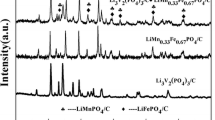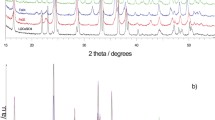Abstract
To find new cathode materials for future applications in lithium-ion batteries, lithium transition metal fluorides represent an interesting class of materials. In principle the Li intercalation voltage can be increased by replacing oxygen in the cathode host structure with the more electronegative fluorine. A facile pyrolytic sol–gel process with trifluoroacetic acid as fluorine source was established to synthesize monoclinic Li3FeF6 using nontoxic chemicals. The acicular Li3FeF6 powder was characterized with X-ray diffraction and a detailed structure model was calculated by Rietveld analysis. For the preparation of cathode films to cycle versus lithium monoclinic Li3FeF6 was ball milled with carbon and binder down to nanoscale. After 100 cycles galvanostatic cycling (C/20) 47 % fully reversible capacity of the initial capacity (129 mAh/g) could be retained. To the best of our knowledge the results presented in this work include the first rate performance test for monoclinic Li3FeF6 up to 1 C maintaining a capacity of 71 mAh/g. The redox reaction involving Fe3+/Fe2+ during Li insertion/extraction was confirmed by post-mortem XPS and cyclic voltammetry.











Similar content being viewed by others
References
Xu B, Qian D, Wang Z, Meng YS (2012) Recent progress in cathode materials research for advanced lithium ion batteries. Mater Sci Eng, R 73:51–65. doi:10.1016/j.mser.2012.05.003
De Dompablo MEAY, Amador U, Tarascon J-M (2007) A computational investigation on fluorinated-polyanionic compounds as positive electrode for lithium batteries. J Power Sources 174:1251–1257. doi:10.1016/j.jpowsour.2007.06.178
Okada S, Ueno M, Uebou Y, Yamaki J (2005) Fluoride phosphate Li2CoPO4F as a high-voltage cathode in Li-ion batteries. J Power Sources 146:565–569. doi:10.1016/j.jpowsour.2005.03.149
Arai H, Okada S, Sakurai Y, Yamaki J (1997) Cathode performance and voltage estimation of metal trihalides. J Power Sources 68:716–719. doi:10.1016/S0378-7753(96)02580-3
Amatucci GG, Pereira N, Badway F, Sina M, Cosandey F, Ruotolo M, Cao C (2011) Formation of lithium fluoride/metal nanocomposites for energy storage through solid state reduction of metal fluorides. J Fluor Chem 132:1086–1094. doi:10.1016/j.jfluchem.2011.06.033
Amatucci GG, Pereira N (2007) Fluoride based electrode materials for advanced energy storage devices. J Fluor Chem 128:243–262. doi:10.1016/j.jfluchem.2006.11.016
Žemva B, Chacon L, Lutar K, Shen C, Allman J, Bartlett N (1995) Syntheses and some properties of new nickel fluorides. J Fluor Chem 71:195–196. doi:10.1016/0022-1139(94)06021-D
Kohl J, Wiedemann D, Nakhal S, Bottke P, Ferro N, Bredow T, Kemnitz E, Wilkening M, Heitjans P, Lerch M (2012) Synthesis of ternary transition metal fluorides Li3MF6 via a sol–gel route as candidates for cathode materials in lithium-ion batteries. J Mater Chem 22:15819–15827. doi:10.1039/c2jm32133e
García Alvarado F, Kuhn A, Gonzalo M, Cándida E (2010) ES 2335854
Kimura A, Mikoshiba E (2010) U.S. 0248025
Schulz-Dobrick M, Lerch M, Ehrenberg H, Nakhal S, Koch J, Frieder S, Herklotz M (2011) U.S. 0227001
Okada S, Gocheva ID, Nishijima M, Takayuki D, Yamaki J (2009) JP 238687
Gocheva ID, Kamimura Y, Doi T, Okada S, Yamaki J, Nisihda T (2009) Direct synthesis of Cryolithe type Li3FeF6 and its charaterization as positive electrode in Li cell. Eng Sci Rep Kyushu Univ 31:7–11
Gonzalo E, Kuhn A, García-Alvarado F (2010) A comparative study of α- and β-Li3FeF6: structure and electrochemical behavior. J Electrochem Soc 157:A1002–A1006. doi:10.1149/1.3454238
Kuhn A, Basa A, Gonzalo EC, Sobrados I, Sanz J (2011) Structure and electrochemical Li insertion properties of cryolite-type Li3FeF6 prepared by precipitation from aqueous-based solutions. Electrode Mater—Arcachon, Fr 5–6
Basa A, Gonzalo E, Kuhn A, García-Alvarado F (2012) Reaching the full capacity of the electrode material Li3FeF6 by decreasing the particle size to nanoscale. J Power Sources 197:260–266. doi:10.1016/j.jpowsour.2011.09.048
Gonzalo E, Kuhn A, García-Alvarado F (2010) On the room temperature synthesis of monoclinic Li3FeF6: a new cathode material for rechargeable lithium batteries. J Power Sources 195:4990–4996. doi:10.1016/j.jpowsour.2010.02.040
Basa A, Gonzalo E, Kuhn A, García-Alvarado F (2012) Facile synthesis of β-Li3VF6: a new electrochemically active lithium insertion material. J Power Sources 207:160–165. doi:10.1016/j.jpowsour.2012.01.148
Gocheva ID, Doi T, Okada S, Yamaki J (2012) Electrochemcial properties of tritrutile-type Li2TiF6 as cathode active material in Li-ion batteries. Electrochemistry 5:471–474
Liao P, Li J, Dahn JR (2010) Lithium intercalation in LiFe2F6 and LiMgFeF6 disordered trirutile-type phases. J Electrochem Soc 157:A355–A361. doi:10.1149/1.3294788
Liao P, Dunlap RA, Dahn JR (2010) In situ mössbauer effect study of lithium intercalation in LiFe2F6. J Electrochem Soc 157:A1080–A1084. doi:10.1149/1.3473809
Baillie MJ, Brown DH, Moss KC, Sharp DWA (1968) Anhydrous metal trifluoroacetates. J Chem Soc A Inorganic, Phys Theor 3110–3114. doi: 10.1039/j19680003110
Dallenbach R, Tissot P (1981) Properties of molten alkali metal trifluoracetates. J Therm Anal 20:409–417. doi:10.1007/BF01912890
Fujihara S, Ono S, Kishiki Y, Tada M, Kimura T (2000) Sol–gel synthesis of inorganic complex fluorides using trifluoroacetic acid. J Fluor Chem 105:65–70. doi:10.1016/S0022-1139(00)00265-7
Fedorov PP, Luginina AA, Kuznetsov SV, Osiko VV (2011) Nanofluorides. J Fluor Chem 132:1012–1039. doi:10.1016/j.jfluchem.2011.06.025
Du Y-P, Zhang Y-W, Sun L-D, Yan C-H (2009) Optically active uniform potassium and lithium rare earth fluoride nanocrystals derived from metal trifluroacetate precursors. Dalt Trans 8574–8581. doi: 10.1039/b909145a
Chalk SG, Miller JF (2006) Key challenges and recent progress in batteries, fuel cells, and hydrogen storage for clean energy systems. J Power Sources 159:73–80. doi:10.1016/j.jpowsour.2006.04.058
Hammersley AP, Brown K, Burmeister W, Claustre L, Gonzalez A, McSweeney S, Mitchell E, Moy JP, Svensson SO, Thompson AW (1997) Calibration and application of an X-ray image intensifier/charge-coupled device detector for monochromatic macromolecular crystallography. J Synchrotron Radiat 4:67–77. doi:10.1107/S0909049596015087
Fujihara S, Tada M, Kimura T (2000) Controlling factors for the conversion of trifluoroacetate sols into thin metal fluoride coatings. J Sol–Gel Sci Technol 19:311–314. doi:10.1023/A:1008729531254
Mosiadz M, Juda KL, Hopkins SC, Soloducho J, Glowacki BA (2011) An in-depth in situ IR study of the thermal decomposition of barium trifluoroacetate hydrate. Thermochim Acta 513:33–37. doi:10.1016/j.tca.2010.11.004
Kagarise RE (1957) Infrared spectrum of trifluoroacetic acid vapor. J Chem Phys 27:519–522. doi:10.1063/1.1743760
Redington RL, Lin KC (1971) Infrared spectra of trifluoroacetic acid and trifluoroacetic anhydride. Spectrochim Acta Part A Mol Spectrosc 27:2445–2460. doi:10.1016/0584-8539(71)80143-5
Jollie DM, Harrison PG (1997) An in situ IR study of the thermal decomposition of trifluoroacetic acid. J Chem Soc Perkin Trans 2:1571–1576. doi:10.1039/a608233e
Massa W (1980) Die Kristallstruktur von β-Li3VF6. Zeitschrift für Krist 153:201–210. doi:10.1524/zkri.1980.153.3-4.201
Massa W, Rüdorff W (1971) Über alpha-und beta-Li3MeF6-Verbindungen.pdf. Zeitschrift für Naturforsch B 26:1216–1218
Schroeder M, Eames C, Tompsett DA, Lieser G, Islam MS, Islam MS (2013) LixFeF6 (x = 2, 3, 4) battery materials: structural, electronic and lithium diffusion properties. Phys Chem Chem Phys 15:20473–20479. doi:10.1039/c3cp53606h
Guo Y-G, Hu J-S, Wan L-J (2008) Nanostructured materials for electrochemical energy conversion and storage devices. Adv Mater 20:2878–2887. doi:10.1002/adma.200800627
Park M, Zhang X, Chung M, Less GB, Marie A (2010) A review of conduction phenomena in Li-ion batteries. J Power Sources 195:7904–7929. doi:10.1016/j.jpowsour.2010.06.060
Plitz I, Badway F, Al-Sharab J, DuPasquier A, Cosandey F, Amatucci GG (2005) Structure and electrochemistry of carbon-metal fluoride nanocomposites fabricated by solid-state redox conversion reaction. J Electrochem Soc 152:A307–A315. doi:10.1149/1.1842035
Badway F, Pereira N, Cosandey F, Amatucci GG (2003) Carbon-metal fluoride nanocomposites. J Electrochem Soc 150:A1209–A1218. doi:10.1149/1.1596162
Sides CR, Croce F, Young VY, Martin CR, Scrosati B (2005) A high-rate, nanocomposite lifepo4/carbon cathode. Electrochem Solid-State Lett 8:A484–A487. doi:10.1149/1.1999916
Rahner D, Machill S, Schlörb H, Siury K, Kloss M, Plieth W (1998) Intercalation materials for lithium rechargeable batteries. J Solid State Electrochem 2:78–84. doi:10.1007/s100080050068
West WC, Soler J, Smart MC, Ratnakumar BV, Firdosy S, Ravi V, Anderson MS, Hrbacek J, Lee ES, Manthiram A (2011) Electrochemical behavior of layered solid solution Li2MnO3 − LiMO2 (M = Ni, Mn, Co) Li-Ion cathodes with and without alumina coatings. J Electrochem Soc 158:A883–A889. doi:10.1149/1.3597319
Grosvenor AP, Kobe BA, Biesinger MC, McIntyre NS (2004) Investigation of multiplet splitting of Fe 2p XPS spectra and bonding in iron compounds. Surf Interface Anal 36:1564–1574. doi:10.1002/sia.1984
Acknowledgments
The authors thank the Helmholtz Association and the Helmholtz Initiative for funding the present work. This work was carried out with the support of the Karlsruhe Nano Micro Facility (KNMF), a Helmholtz Research Infrastructure at KIT. The authors thank Dr. Bergfeld (IAM-AWP, KIT) for the ICP measurements.
Conflict of interest
The authors declare no competing financial interest.
Author information
Authors and Affiliations
Corresponding authors
Electronic supplementary material
Below is the link to the electronic supplementary material.
10971_2014_3329_MOESM1_ESM.tif
As can be seen in the FTIR Spectra (Fig 12) the organic content of the pristine precursor is not fully pyrolysed at 275 °C. This organic content can be removed by washing with acetone or increasing the final reaction temperature up to 350 °C. (TIFF 753 kb)
Rights and permissions
About this article
Cite this article
Lieser, G., Schroeder, M., Geßwein, H. et al. Sol–gel processing and electrochemical characterization of monoclinic Li3FeF6 . J Sol-Gel Sci Technol 71, 50–59 (2014). https://doi.org/10.1007/s10971-014-3329-1
Received:
Accepted:
Published:
Issue Date:
DOI: https://doi.org/10.1007/s10971-014-3329-1




